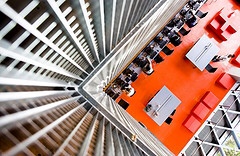I'm playing a new game recently, it's called “Did I just say that?” I have found myself in the middle of conversations or presentations to groups saying things that even five years ago I would have argued against, and I certainly would never had said myself. Usually these are not complete about faces like my opinion about the ipad, most often they are more extreme views about subjects I've been talking about for some time. However, my former timid language of accomodation (“Even as technology rich world, there will be a need for non-tech teachers.”) is replaced with more extreme versions or absolutes.
One area I have waffled (like the good Belgian I am) for some time has been on the subject of books and libraries. Conscious of the immense store of assigned value and nostalgia for traditional paper books, I've always tried to carve out a position that expressed my views while allowing “safety space” for those in the audience. “Electronic books will improve and grow and will take their place alongside traditional forms, creating the best of all worlds for all types of readers,” was my safe position, designed to invite but not offend, not threaten. This always received shaky nods, applause, and invitations to speak again.
So I've been as surprised as anyone else when I have recently heard a differnt position coming out of my mouth in private and public. My message of comfort and accomodation no longer resonates as true for me. I do not see parallel survival of the paper book and the electronic book; the ebook is going to win, and faster than I ever thought. There will be few general uses for “retro books,” and as these uses become fewer and fewer, publishers will no longer invest the capital of the expensive publication process which will speed the spiral. I can't pretend that I'm not announcing the death of formerly vital school features, the textbook, the bookstore, the book sale, the library…
What about libraries? These dens of learning and refuge have been the launching pad for academic careers and the interior life of most who read this today. Our nostalgia for the look, the smell, and the feel of these havens chimes at our deepest core, yet this nostalgia often flies in the face of reality. I remember how troubled I was when the card catalog was removed from my college library, yet today I couldn't picture myself thumbing through cards and copying Dewey Decimal codes on to slips of paper. The digital data base catalog gives me more information more quickly…including whether the book is there or not.
But what if books were always “there”? One of the advantages (and challenges) of digital resources is that they can be infinitely replicated. Barring financial concerns (a topic for another post) there is no longer any reason why everything should not be available to everyone everywhere. Even legacy material eventually will be available in digital form. The greatest library in the world will be in my iPad…and yours…and yours.
So back to the question about libraries. Should schools simply convert them into classrooms? rent them out to local businesses? turn them into museums? Before we move too quickly on this, we need to consider a larger definition of library, what is has been and what it can be.
I recently visited a school with a beautiful library, a huge space with an enormous collection. Just as an experiment, I visited that library at three different times during the day. Each time I visited there were between fifty and a hundred students there, a few socializing, but most seriously at work. The only thing they all had in common: not one was touching a paper book or a magazine. The school had implemented an iPad program for all students, and they had quickly switched their model of research and reading. “Books” were out everywhere, but they were on digital screens.
This experience made me pause, not in surprise over the digital shift, but in the fact that they were still there. This school had beautiful student gathering spaces both inside and out, classrooms open for student use, and a huge cafeteria, but students still went to the library as if by some vestigial muscle memory of this being the place to study.
I think it's more than that, which speaks to the future of these vital (yes, vital) school spaces. I think the future remodeled library (or whatever we call it…just please, for the love of all that's holy, let's not call it a Cybrary) can be the moden commons, a multiple use area available to all joined by a few agreed rules of etiquette. The library does not belong to any student or class, but to all. It's mission is to provide a space that supports the academic mission of the school. Resources can be picked and designed to serve this purpose: group study rooms, tech training and support, higher level computing and production tools.
The library doesn't have to be a storage space for unused books, nor does it have to disappear. It can become the embodiment of a schools mission and identity.
I'll talk about what to do with public libraries in another posts…I need to get this one posted before the web starts floating obituaries of me.
As always, I invite your comments.
Image: 'I Can Gather All the News I+Need+on+the+Weather+Report' http://www.flickr.com/photos/51035555243@N01/2671536366 Found on flickrcc.net

I feel ebooks will win also. The students need to eliminate the 50lbs. backpacks and the convenience is something educators need to consider. If it can be done digitally there is no reason to do the old way.